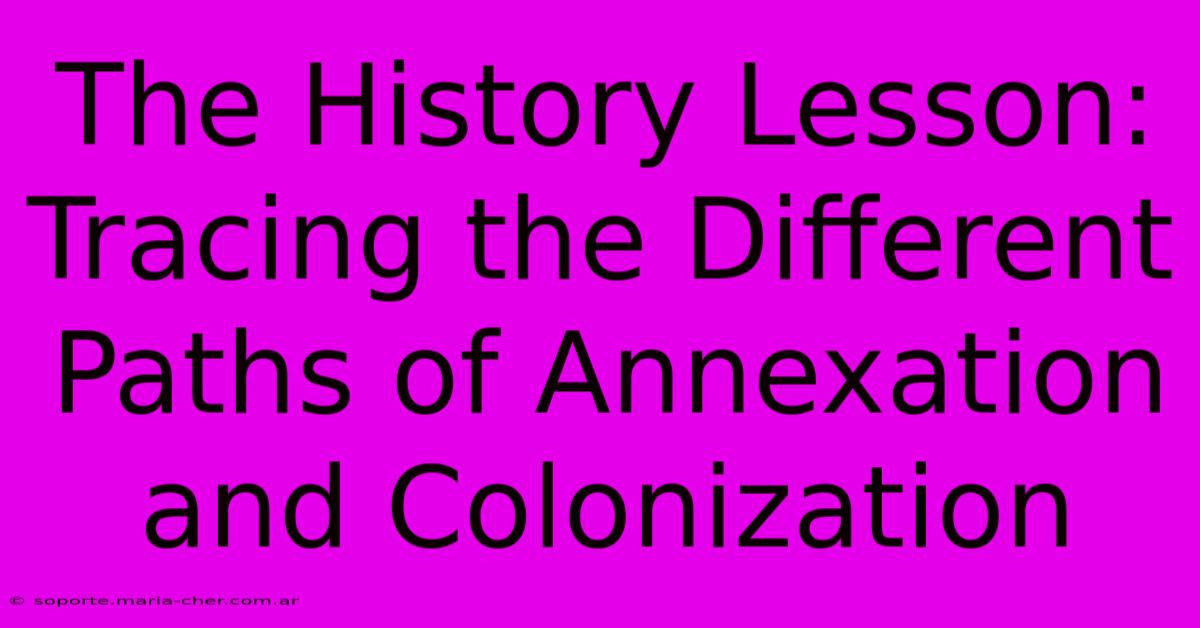The History Lesson: Tracing The Different Paths Of Annexation And Colonization

Table of Contents
The History Lesson: Tracing the Different Paths of Annexation and Colonization
The terms "annexation" and "colonization" are often used interchangeably, but they represent distinct historical processes with different motivations, methods, and consequences. Understanding their nuances is crucial to grasping the complexities of global history and its enduring impact on the modern world. This article delves into the historical paths of annexation and colonization, highlighting their key differences and shared characteristics.
Annexation: A Focus on Territory
Annexation, at its core, is the formal acquisition of territory by a state. It often involves the incorporation of a previously independent region or territory into the existing political and administrative structure of the annexing power. While force might be involved, annexation doesn't always necessitate outright conquest. It can occur through various means, including:
Methods of Annexation:
- Treaty or Agreement: Peaceful transfers of territory, often following negotiations or agreements between states. This could involve cession (giving up territory) or purchase. The Louisiana Purchase by the United States from France is a prime example.
- Conquest and Military Force: This involves the subjugation of a territory through military means, followed by its formal incorporation into the victor's domain. The annexation of Crimea by Russia in 2014 is a more recent, and highly contested, instance.
- Claim of Uninhabited Land: Historically, states have claimed territories deemed uninhabited, based on principles of discovery or "terra nullius," a concept largely discredited today.
Motivations Behind Annexation:
- Strategic Geographic Location: Acquiring territories with strategic importance for defense, trade routes, or resource access.
- Resource Acquisition: Securing access to valuable natural resources like minerals, timber, or fertile land.
- Population Growth and Expansion: Increasing the size of a nation's territory to accommodate a growing population or to claim more land for settlement.
- National Prestige and Power: Annexation can enhance a nation's international standing and project its power.
Colonization: A Broader and More Complex Process
Colonization is a far more multifaceted process than annexation. While it often involves territorial acquisition, it goes beyond mere land grabbing. It encompasses the establishment of settlements and political control over a territory, often involving significant demographic changes, the exploitation of resources, and the imposition of the colonizer's culture and institutions.
Key Features of Colonization:
- Settlement and Migration: The movement of settlers from the colonizing power to the colonized territory, often leading to significant demographic shifts and the displacement or marginalization of the indigenous population.
- Economic Exploitation: The extraction of resources and labor from the colonized territory for the benefit of the colonizing power. This frequently involved systems of forced labor and unequal trade relations.
- Cultural and Political Domination: The imposition of the colonizer's language, culture, religion, and political system, often leading to the suppression of indigenous cultures and traditions.
- Creation of Administrative Structures: The establishment of colonial governments and administrative systems to manage and control the colonized territory.
Types of Colonization:
- Settlement Colonization: Characterized by significant migration of settlers from the colonizing power. Examples include the British colonization of North America and Australia.
- Exploitation Colonization: Primarily focused on the extraction of resources and labor, with less emphasis on large-scale settlement. The Belgian Congo under King Leopold II serves as a stark example.
Overlapping and Diverging Paths
While distinct, annexation and colonization often overlapped and intertwined throughout history. Many instances of colonization began with annexation, providing the legal framework for subsequent settlement and exploitation. However, not all annexations led to colonization, and some colonized territories were never formally annexed.
The Legacy of Annexation and Colonization
Both annexation and colonization have left indelible marks on the world. The legacy includes:
- Political Instability and Conflict: The arbitrary drawing of borders and the imposition of foreign rule have fueled conflicts and instability in many post-colonial regions.
- Economic Inequality: The exploitation of resources during colonization continues to contribute to economic disparities between former colonizers and colonized nations.
- Cultural and Social Impacts: The suppression of indigenous cultures and the imposition of foreign languages and religions have had profound and long-lasting social and cultural consequences.
Understanding the distinct histories of annexation and colonization is essential for analyzing current geopolitical realities and for fostering a more just and equitable future. It necessitates a critical examination of the past to address the ongoing challenges and legacies of these powerful historical forces.

Thank you for visiting our website wich cover about The History Lesson: Tracing The Different Paths Of Annexation And Colonization. We hope the information provided has been useful to you. Feel free to contact us if you have any questions or need further assistance. See you next time and dont miss to bookmark.
Featured Posts
-
The Language Of Flowers Express Your Love With Mothers Day Blooms That Speak Volumes
Feb 04, 2025
-
The Ultimate Gif Diet How To Lose Bytes Without Losing Impact
Feb 04, 2025
-
Discover The Power Of Active Voice Enhance Your Writing
Feb 04, 2025
-
Unlock Your Dream Home In The Heart Of Dallas Perry Homes Enchanting Creations
Feb 04, 2025
-
The Forgotten Art Of Worship Rediscovering Its Relevance In Modern Times
Feb 04, 2025
